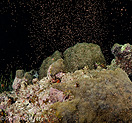News
Capturing undersea mating ritual

Anke Klueter sets up a tent to try to capture some of the egg-sperm bundles released by coral into the surrounding sea. Photo: PHILLIP GILLETTE, UNIVERSITY OF MIAMI
-
 Print
Print -
 Comments
Comments
-
The coral simultaneously releases bundles of egg and sperm. Click on the image to see a larger version. Photo: PHILLIP GILLETTE, UNIVERSITY OF MIAMI
“OMG, I think they just spawned on me!”
That was the title of a September blog entry by UB’s Buffalo Undersea Reef Research laboratory (BURR), which sent five UB investigators to the Florida Keys this month to study an underwater mating ritual: coral spawning.
Mary Alice Coffroth, professor of geology, led the research trip. She explains that corals—which are animals—reproduce by releasing bundles of egg and sperm into the surrounding sea. The goal of the visit to Florida was to collect these bundles and raise young coral for use in scientific studies.
Among other topics, Coffroth’s research team examines how an algal symbiont in the genus Symbiodinium facilitates the establishment of coral reefs.
“It is a symbiosis between corals and a single-celled dinoflagellate alga, Symbiodinium, that allows the corals to grow into these massive structures,” Coffroth says. “Most corals acquire their symbionts anew each generation, and my lab is investigating the early ontogeny of this symbiosis.”
The BURR lab’s coral spawning blog, created by BURR member Rachel Mellas, provides an intimate look at the corals’ mating process and at the research team’s daily life in Florida. The scientists carried out their work at the Alligator and Looe Key reefs off the Florida coast, where schools of tropical fish dart through turquoise waters.
Gathering and rearing the coral was a massive undertaking, and the BURR scientists were joined by more than 20 volunteers from South Florida that assisted in all aspects of work.
The Sept. 13 blog entry captures the team’s excitement at finally witnessing coral spawning:
“We were relieved to see that it was actually happening! In preparation for a synchronized release of their egg-sperm bundles, coral polyps will move these pinkish balls into their mouth causing the polyps to swell and the egg-sperm bundles to be visible in the polyp mouth. Setting gives us about a 15-20 minute window to get our dive and snorkel teams into the water and to get ready to collect before the spawning begins.
“An amazing phenomenon is that the rest of the organisms on the reef seem to know what is coming and come out of their usual hiding place. When the spawning begins, these organisms take advantage of the extra food in the water as well and we can actually feel them on our hands, face and any exposed skin. We saw brittle stars, mysid shrimps and many fish active on the reef that night. We waited patiently with the rest of the reef community until, almost all at once, around 11:15 p.m., all of the Montastrea faveolata colonies released these bundles into the water where they slowly float to the surface (or into our collecting jars).”
Unfortunately—as often is the case with fieldwork—the research mission did not go as hoped. Though the scientists obtained some coral and sperm samples for research, none of the young coral the team raised survived. Shelby McIlroy, Coffroth’s graduate student, will travel to Curacao at the start of October to try and catch the coral spawn there so the BURR lab can continue its experiments.
The coral spawning fieldwork supports a number of BURR projects, such as research scientist Anke Kleuter’s investigation into why the coral species Montastrea faveolata is compatible with some algal symbionts, but not others.
McIlroy, a PhD candidate, is studying the benefits to the coral of having one symbiont type versus another. She is looking at growth, survivorship and temperature sensitivity of young M. faveolata corals with different types Symbiodinium. This line of inquiry will help scientists understand and predict how reefs will fare in warming oceans. And master’s student DJ Valint is studying whether certain species of adult corals pass their algal symbionts along to their offspring in the egg-and-sperm bundles.
“Why study reefs? Reefs are important apart from their intrinsic beauty and high biodiversity,” Coffroth says. “There are important economic reasons to care about coral reefs. Coral reefs can be a rich source of natural products with important pharmaceutical applications. They are also an important barrier against shoreline erosion. Coral reefs support commercial and recreational fisheries, and they are one of the primary attractions for millions of snorkelers and recreational scuba divers.”


Reader Comments